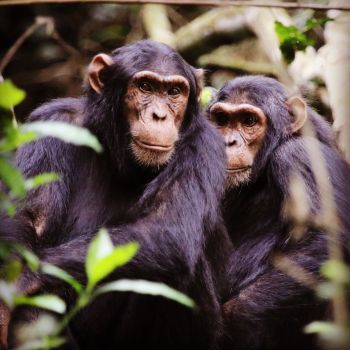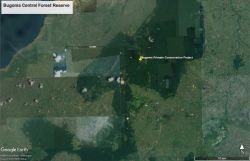Difference between revisions of "Bugoma Central Forest Reserve"
(Created page with "<!-- INSTRUCTIONS FOR UPLOADING SITE INFORMATION - Wiki pages contain information in paragraphs, tables, lists, and images. - Text and images are not restricted, and their for...") |
(No difference)
|
Revision as of 12:49, 20 November 2020
East Africa > Uganda > Bugoma Central Forest Reserve
Summary
- Eastern chimpanzees (Pan troglodytes schweinfurthii) are present in Bugoma Central Forest Reserve.
- The chimpanzee population size is unknown; the density in 2006 was 1.99 individuals per km².
- The chimpanzee population trend is unknown.
- The site has a total size of 400 km².
- Key threats to chimpanzees are hunting and clearing land for agriculture.
- Conservation activities have focused on providing clean water access and raising conservation awareness.
Site characteristics
|400 km² |- |Coordinates |1.304 N, 31.016 E |- |Designation |Central Forest Reserve |- |Habitat types |Subtropical/tropical moist lowland |} IUCN habitat categories Site designations
Ape status
In 2006, the density of chimpanzees was estimated to be 1.99 chimpanzees/km² (Plumptre & Cox 2006).
Table 2. Ape population estimates in Bugoma Central Forest Reserve
| Species | Year | Abundance estimate (95% CI) | Density estimate [ind./ km²] (95% CI) | Encounter rate (nests/km) | Area | Method | Source | Comments | A.P.E.S. database ID |
|---|---|---|---|---|---|---|---|---|---|
| Pan troglodytes schweinfurthii | 2006 | 1.99 | Bugoma Forest | Line transects (Distance) | Plumptre & Cox 2006 | Survey effort: 511.2 km |
Threats
Table 3. Threats to apes in Bugoma Central Forest Reserve
| Category | Specific threats | Threat level | Quantified severity | Description | Year of threat |
|---|---|---|---|---|---|
| 1. Residential & commercial development | Absent | ||||
| 2. Agriculture & aquaculture | 2.1 Annual & perennial non-timber crops | Present, but threat severity is unknown | Encroachment of forest habitat for farming affecting the boundaries (Hobaiter & Gruber pers. comm. 2020). Sugarcane companies are clearing land within the reserve (Lewton 2020). | Ongoing (2020) | |
| 3. Energy production & mining | Absent | ||||
| 4. Transportation & service corridors | 4.1 Roads & railroads | Present, but threat severity is unknown | Busy dirt road cuts through the main forest block and divides chimpanzees' (and other species') territory - danger from speeding vehicles (Hobaiter & Gruber pers. comm. 2020). | Ongoing (2020) | |
| 5. Biological resource use | 5.1 Hunting & collecting terrestrial animals | Present, but threat severity unknown | The whole forest is affected. | Snares placed for duiker and bush pigs also trap chimpanzees. Chimpanzees are also directly targeted by hunters (Hobaiter & Gruber pers. comm. 2020). | Ongoing (2020) |
| 5. Biological resource use | 5.3 Logging & wood harvesting | Present, but threat severity is unknown | The whole forest is affected. | Illegal logging is present throughout forest, in particular outside of the immediate research areas; includes chimpanzee feeding species. Trees illegally felled for charcoal burning and firewood, particularly around the boundaries (Hobaiter & Gruber pers. comm. 2020). | Ongoing (2020) |
| 6. Human intrusion & disturbance | Absent | ||||
| 7. Natural system modifications | Absent | ||||
| 8. Invasive & other problematic species, genes, diseases | 8.4 Problematic species/diseases of unknown origin | Present, but threat severity is unknown | The whole forest is affected. | Respiratory outbreaks. Other sites in Uganda have confirmed similar respiratory pathogens of human origin (Hobaiter & Gruber pers. comm. 2020). | Ongoing (2020) |
| 9. Pollution | Absent | ||||
| 10. Geological Events | Absent | ||||
| 11. Climate change & severe weather | 11.1 Habitat shifting & alteration | Present, but threat severity is unknown | The whole forest is affected. | Some evidence that there is decreasing fruiting in forest trees, perhaps impacted by increase in overnight temperature lows (Hobaiter & Gruber pers. comm. 2020). | Ongoing (2020) |
| 12. Other options | Absent |
Conservation activities
The Bugoma Primate Conservation Project was established in 2015, and works in collaboration with local communities surrounding the reserve on a number of conservation activities, including school classes, plastic waste recycling, and clean water programs.
Table 4. Conservation activities in Bugoma Central Forest Reserve
| Category | Specific activity | Description | Year of activity |
|---|---|---|---|
| 1. Residential & commercial development | Not reported | ||
| 2. Agriculture & aquaculture | Not reported | ||
| 3. Energy production & mining | Not reported | ||
| 4. Transportation & service corridors | Not reported | ||
| 5. Biological resource use | Not reported | ||
| 6. Human intrusion & disturbance | Not reported | ||
| 7. Natural system modifications | Not reported | ||
| 8. Invasive & other problematic species, genes, diseases | Not reported | ||
| 9. Pollution | Not reported | ||
| 10. Education & Awareness | 10.5. Implement multimedia campaigns using theatre, film, print media, and discussions | The Bugoma Primate Conservation Project visits local schools and communities to talk about the Bugoma Forest, and hold conservation film nights (Bugoma Primate Conservation Project n.d.) | Ongoing |
| 11. Habitat Protection | Not reported | ||
| 12. Species Management | Not reported | ||
| 13. Livelihood; Economic & Other Incentives | Clean water access program (Bugoma Primate Conservation Project n.d.) | Ongoing |
Conservation activities list (Junker et al. 2017)
Challenges
Table 5. Challenges reported for Bugoma Central Forest Reserve
| Challenge | Source |
|---|---|
| Civil unrest | (Hobaiter & Gruber pers. comm. 2020) |
Research activities
Following initial surveys in 2015, systematic habituation of chimpanzee communities started in 2016 and is ongoing. Several groups of Ugandan mangabey are already habituated. Systematic data collection on chimpanzee behaviour, forest tree phenology, illegal activities, rainfall, and temperature are collected by the Bugoma Primate Conservation Project.
Documented behaviours
Table 6. Ape behaviors reported for Bugoma Central Forest Reserve
| Behavior | Source |
|---|---|
| Not reported |
External links
Bugoma Primate Conservation Project
Bugoma Primate Conservation Project on Twitter
Relevant datasets
References
Lewton, T. (2020, November 5). Uganda environment authority greenlights clearing of Bugoma Forest. Online: https://news.mongabay.com/2020/11/uganda-environment-authority-greenlights-clearing-of-bugoma-forest/
Plumptre, A.J., & Cox, D. (2006). Counting primates for conservation: primate surveys in Uganda. Primates, 47, 65-73.
Bugoma Primate Conservation Project (n.d.) Retrieved from: https://bugomaprimates.wp.st-andrews.ac.uk/research/
Page completed by: Cat Hobaiter & Thibaud Gruber Date: 18/11/2020

